dbatools.io = command-line SQL Server Management Studio - Let me see
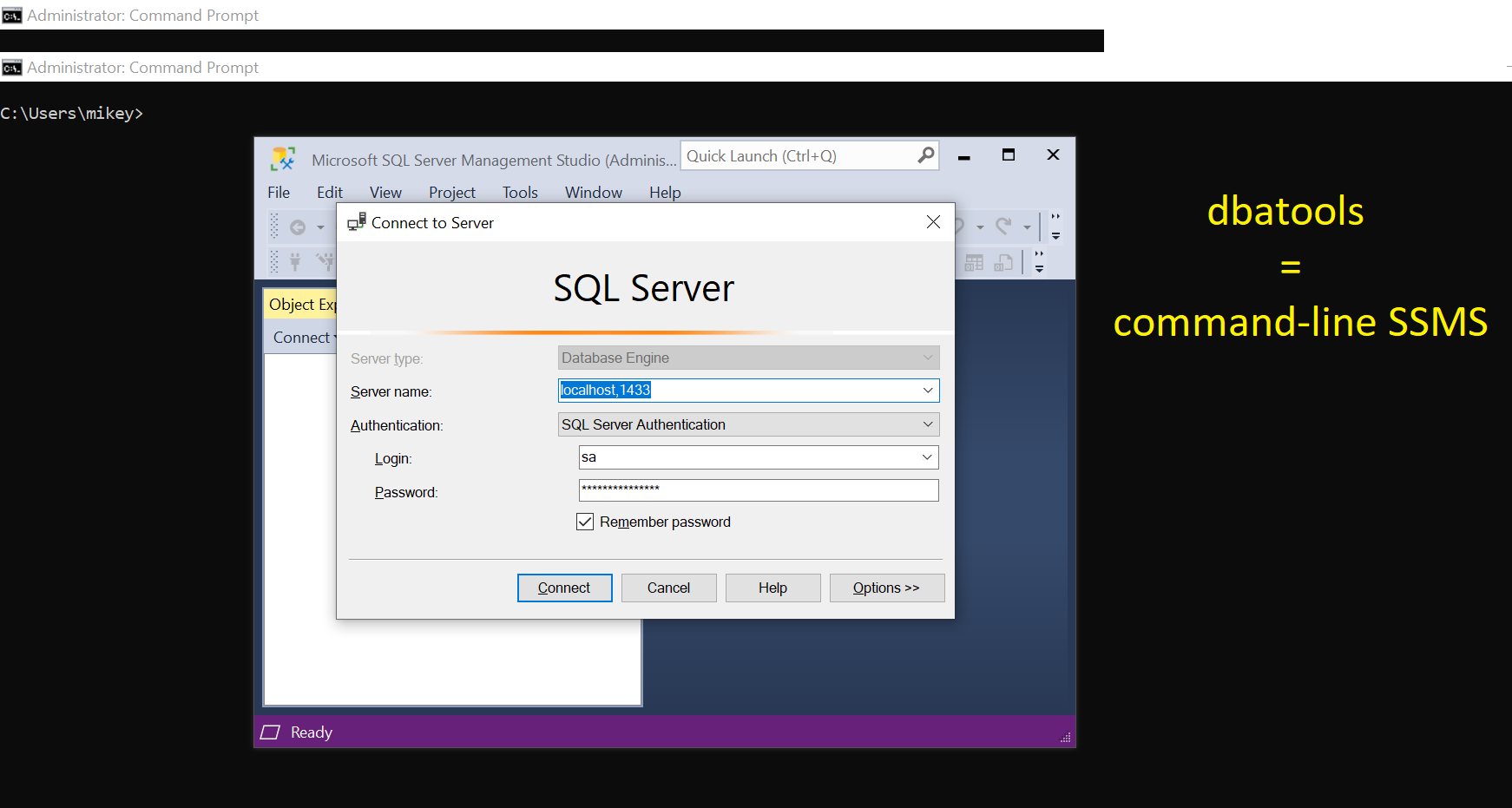
This post is part of the series showing practical usage examples. The main post covering links to all posts can be found here: dbatools.io = command-line SQL Server Management Studio: Table of contents.
See the databases
When I want to quickly check the databases in the SSMS I would use this:
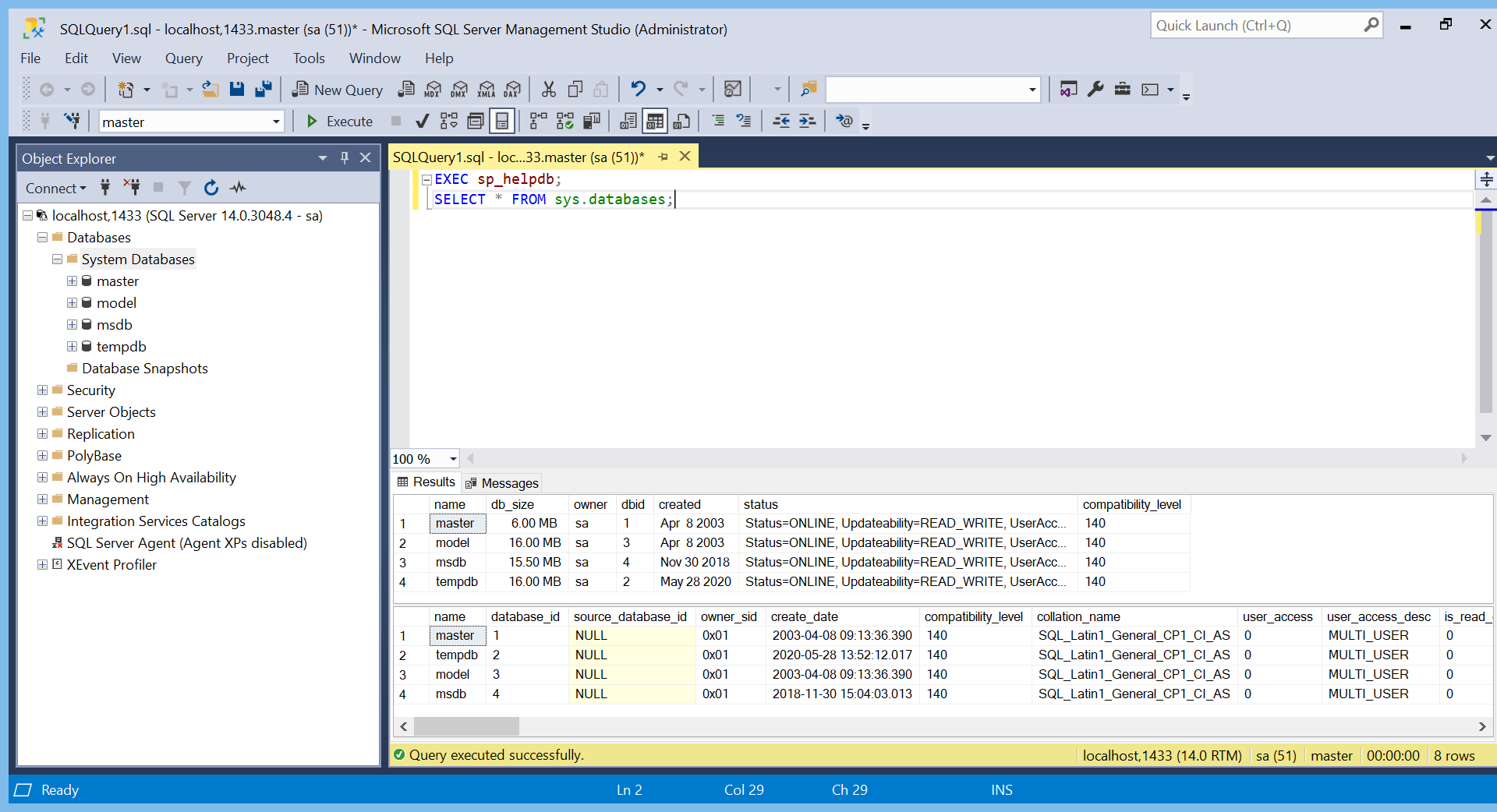 With dbatools I can run the following command:
With dbatools I can run the following command:
Get-DbaDatabase
# see all the databases
Get-DbaDatabase -SqlInstance $server | Format-Table
<#
ComputerName InstanceName SqlInstance Name Status IsAccessible RecoveryModel LogReuseWaitStatus SizeMB Compatibility Collation Owner LastFullBackup
------------ ------------ ----------- ---- ------ ------------ ------------- ------------------ ------ ------------- --------- ----- --------------
localhost MSSQLSERVER 4dc570825344 master Normal True Simple Nothing 6 Version140 SQL_Latin1_General_CP1_CI_AS sa 01/01/0001 ...
localhost MSSQLSERVER 4dc570825344 tempdb Normal True Simple Nothing 16 Version140 SQL_Latin1_General_CP1_CI_AS sa 01/01/0001 ...
localhost MSSQLSERVER 4dc570825344 model Normal True Full Nothing 16 Version140 SQL_Latin1_General_CP1_CI_AS sa 01/01/0001 ...
localhost MSSQLSERVER 4dc570825344 msdb Normal True Simple Transaction 15.5 Version140 SQL_Latin1_General_CP1_CI_AS sa 01/01/0001 ...
#>
In a comparable way we can see details of a single database:
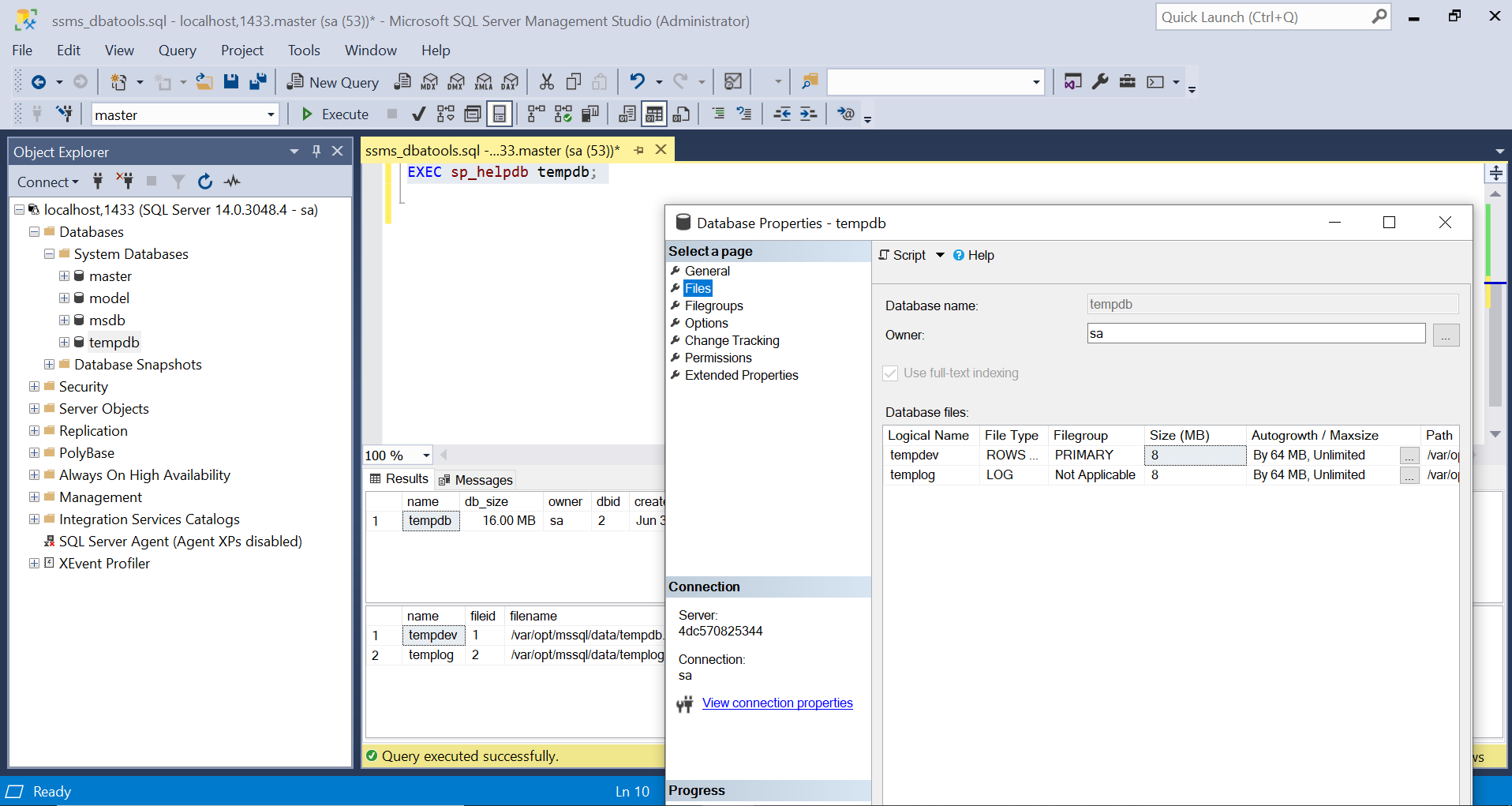
Get-DbaDbFile
# get the files details
Get-DbaDbFile -SqlInstance $server -Database tempdb | Format-Table
<#
ComputerName InstanceName SqlInstance Database FileGroupName ID Type TypeDescription LogicalName PhysicalName
------------ ------------ ----------- -------- ------------- -- ---- --------------- ----------- ------------
localhost MSSQLSERVER 4dc570825344 tempdb PRIMARY 1 0 ROWS tempdev /var/opt/mssql/data/tempdb.mdf
localhost MSSQLSERVER 4dc570825344 tempdb 2 1 LOG templog /var/opt/mssql/data/templog.ldf
#>
Get-DbaDbSpace
# get extra information on free/used space in files
Get-DbaDbSpace -SqlInstance $server -Database tempdb| Format-Table
<#
ComputerName InstanceName SqlInstance Database FileName FileGroup PhysicalName FileType UsedSpace FreeSpace
------------ ------------ ----------- -------- -------- --------- ------------ -------- --------- ---------
localhost MSSQLSERVER 4dc570825344 tempdb tempdev PRIMARY /var/opt/mssql/data/tempdb.mdf ROWS 3.00 MB 5.00 MB
localhost MSSQLSERVER 4dc570825344 tempdb templog /var/opt/mssql/data/templog.ldf LOG 1,024.00 KB 7.00 MB
#>
See the jobs
The SQL Server Agent is crucial component and being able to see what is happening inside is important. In SSMS we would click here and there and see windows like that:
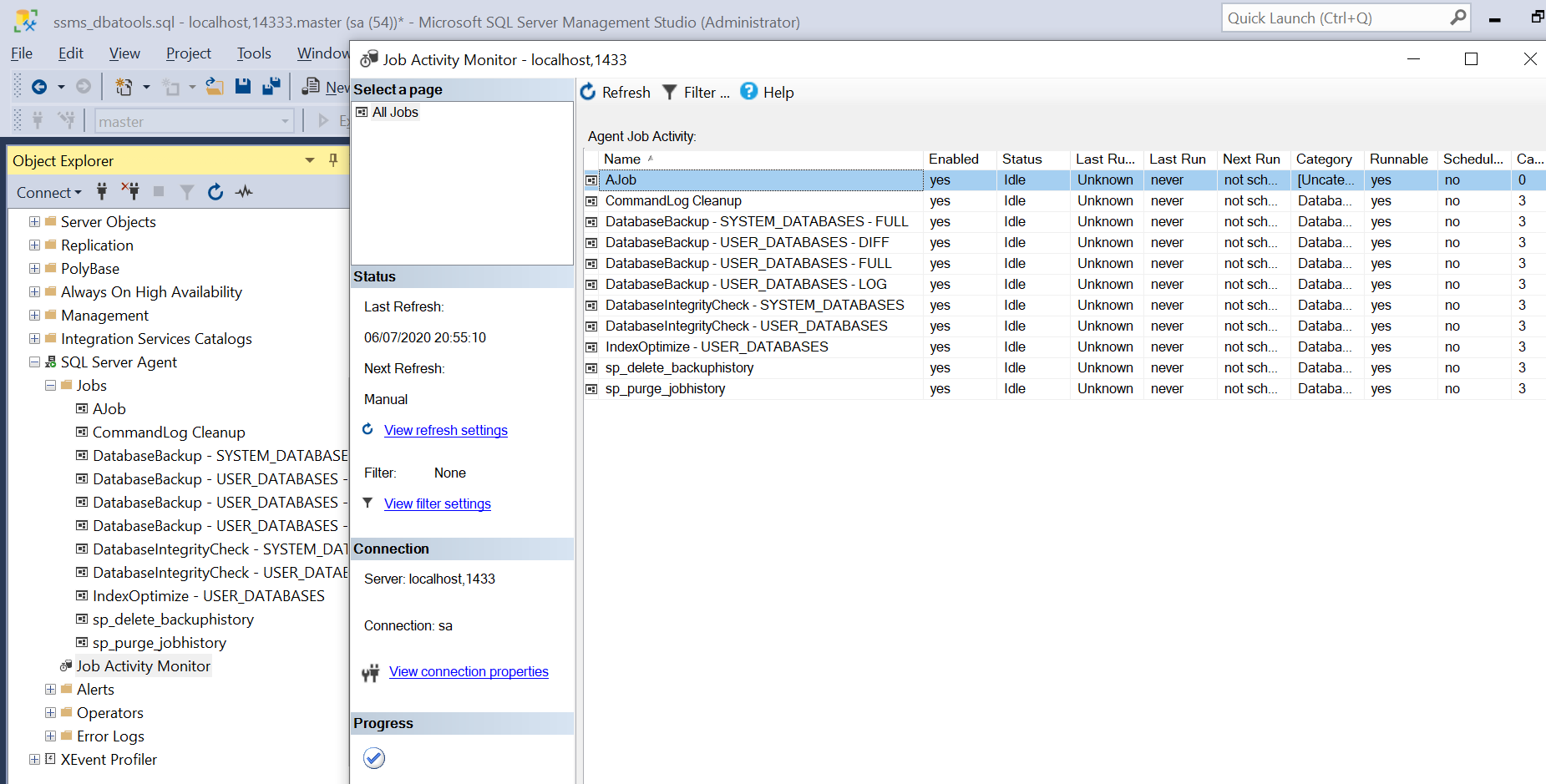
Getting job’s details is as easy as opening one and navigating few tabs:
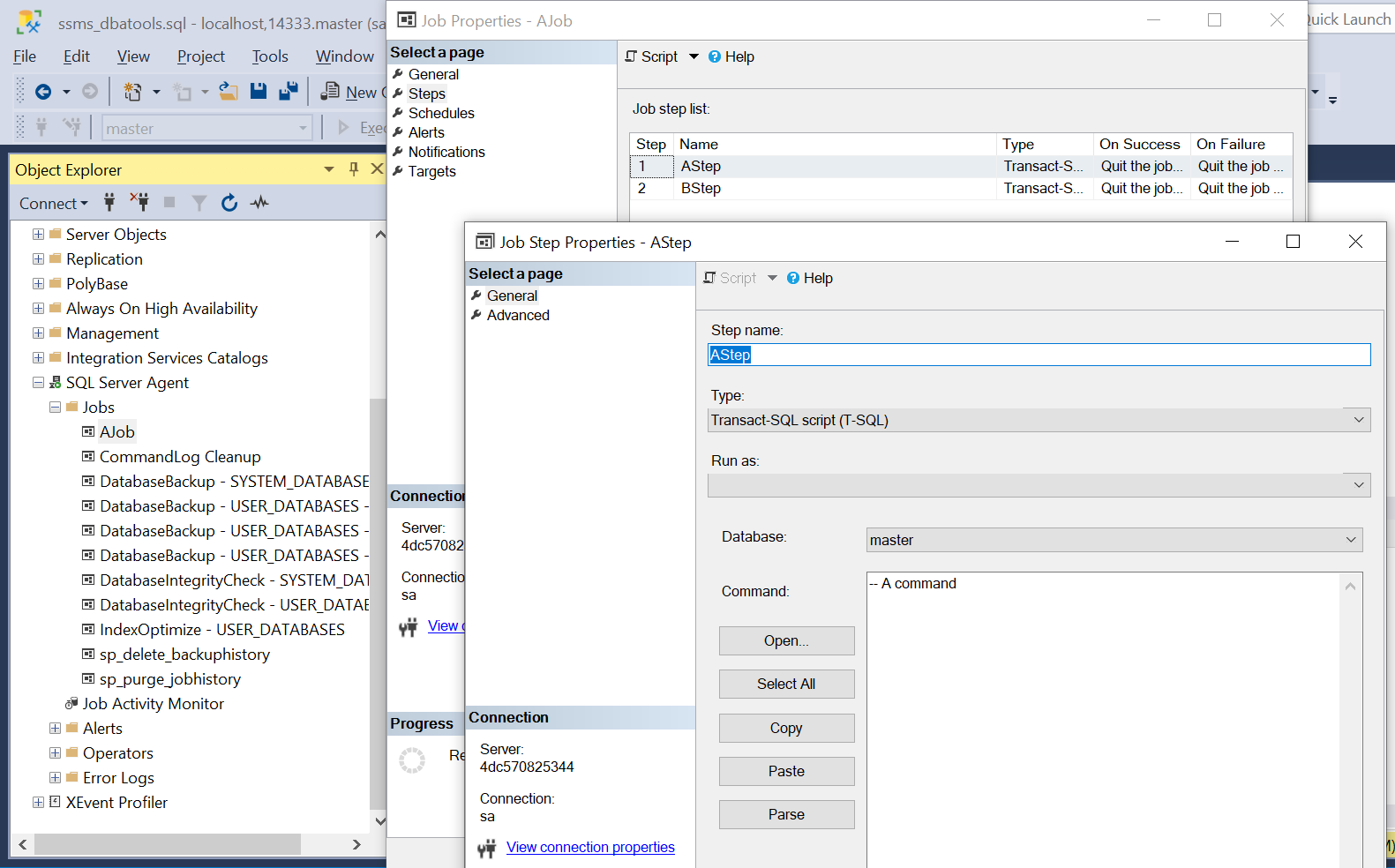
Now, let’s switch to dbatools and see what they offer.
dbatools: Get-DbaAgentJob
# see the jobs
Get-DbaAgentJob -SqlInstance $server | Format-Table
<#
ComputerName InstanceName SqlInstance Name Category OwnerLoginName CurrentRunStatus CurrentRunRetryAttempt Enabled
------------ ------------ ----------- ---- -------- -------------- ---------------- ---------------------- -------
localhost MSSQLSERVER 4dc570825344 AJob Database Maintenance sa Idle 0 True
localhost MSSQLSERVER 4dc570825344 CommandLog Cleanup Database Maintenance sa Idle 0 True
localhost MSSQLSERVER 4dc570825344 DatabaseBackup - SYSTEM_DATABASES - FULL Database Maintenance sa Idle 0 True
localhost MSSQLSERVER 4dc570825344 DatabaseBackup - USER_DATABASES - DIFF Database Maintenance sa Idle 0 True
localhost MSSQLSERVER 4dc570825344 DatabaseBackup - USER_DATABASES - FULL Database Maintenance sa Idle 0 True
localhost MSSQLSERVER 4dc570825344 DatabaseBackup - USER_DATABASES - LOG Database Maintenance sa Idle 0 True
localhost MSSQLSERVER 4dc570825344 DatabaseIntegrityCheck - SYSTEM_DATABASES Database Maintenance sa Idle 0 True
localhost MSSQLSERVER 4dc570825344 DatabaseIntegrityCheck - USER_DATABASES Database Maintenance sa Idle 0 True
localhost MSSQLSERVER 4dc570825344 IndexOptimize - USER_DATABASES Database Maintenance sa Idle 0 True
localhost MSSQLSERVER 4dc570825344 sp_delete_backuphistory Database Maintenance sa Idle 0 True
localhost MSSQLSERVER 4dc570825344 sp_purge_jobhistory Database Maintenance sa Idle 0 True
#>
Get-DbaAgentJobStep
# see the job steps details
Get-DbaAgentJobStep -SqlInstance $server | Format-Table
<#
ComputerName InstanceName SqlInstance AgentJob Name SubSystem LastRunDate LastRunOutcome
------------ ------------ ----------- -------- ---- --------- ----------- --------------
localhost MSSQLSERVER 4dc570825344 AJob AStep TransactSql 01/01/0001 00:00:00 Failed
localhost MSSQLSERVER 4dc570825344 AJob BStep TransactSql 01/01/0001 00:00:00 Failed
localhost MSSQLSERVER 4dc570825344 CommandLog Cleanup CommandLog Cleanup TransactSql 01/01/0001 00:00:00 Failed
localhost MSSQLSERVER 4dc570825344 DatabaseBackup - SYSTEM_DATABASES - FULL DatabaseBackup - SYSTEM_DATABASES - FULL TransactSql 01/01/0001 00:00:00 Failed
localhost MSSQLSERVER 4dc570825344 DatabaseBackup - USER_DATABASES - DIFF DatabaseBackup - USER_DATABASES - DIFF TransactSql 01/01/0001 00:00:00 Failed
localhost MSSQLSERVER 4dc570825344 DatabaseBackup - USER_DATABASES - FULL DatabaseBackup - USER_DATABASES - FULL TransactSql 01/01/0001 00:00:00 Failed
localhost MSSQLSERVER 4dc570825344 DatabaseBackup - USER_DATABASES - LOG DatabaseBackup - USER_DATABASES - LOG TransactSql 01/01/0001 00:00:00 Failed
localhost MSSQLSERVER 4dc570825344 DatabaseIntegrityCheck - SYSTEM_DATABASES DatabaseIntegrityCheck - SYSTEM_DATABASES TransactSql 01/01/0001 00:00:00 Failed
localhost MSSQLSERVER 4dc570825344 DatabaseIntegrityCheck - USER_DATABASES DatabaseIntegrityCheck - USER_DATABASES TransactSql 01/01/0001 00:00:00 Failed
localhost MSSQLSERVER 4dc570825344 IndexOptimize - USER_DATABASES IndexOptimize - USER_DATABASES TransactSql 01/01/0001 00:00:00 Failed
localhost MSSQLSERVER 4dc570825344 sp_delete_backuphistory sp_delete_backuphistory TransactSql 01/01/0001 00:00:00 Failed
localhost MSSQLSERVER 4dc570825344 sp_purge_jobhistory sp_purge_jobhistory TransactSql 01/01/0001 00:00:00 Failed
#>
With some modification we can even get the Command quickly.
# see the command of a selected job step
Get-DbaAgentJobStep -SqlInstance $server -Job Ajob| SELECT AgentJob, Name, Command | Out-GridView
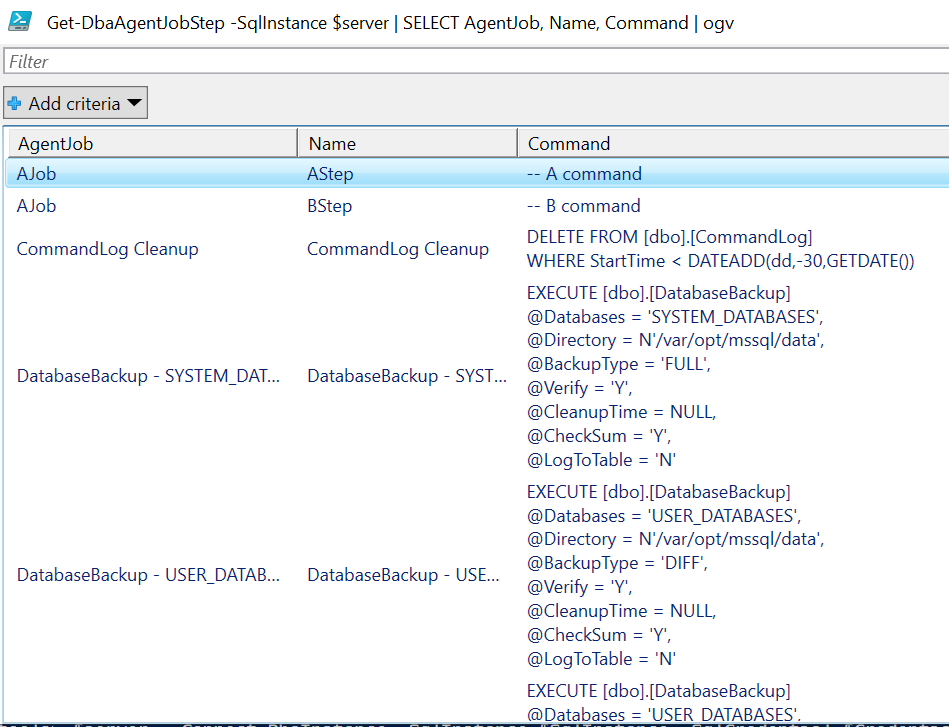
See the logins/users/roles
Another important aspect of taking care of the server is user management. In this part, we will see how to quickly check basic information about users, logins, and roles. First, start with logins:
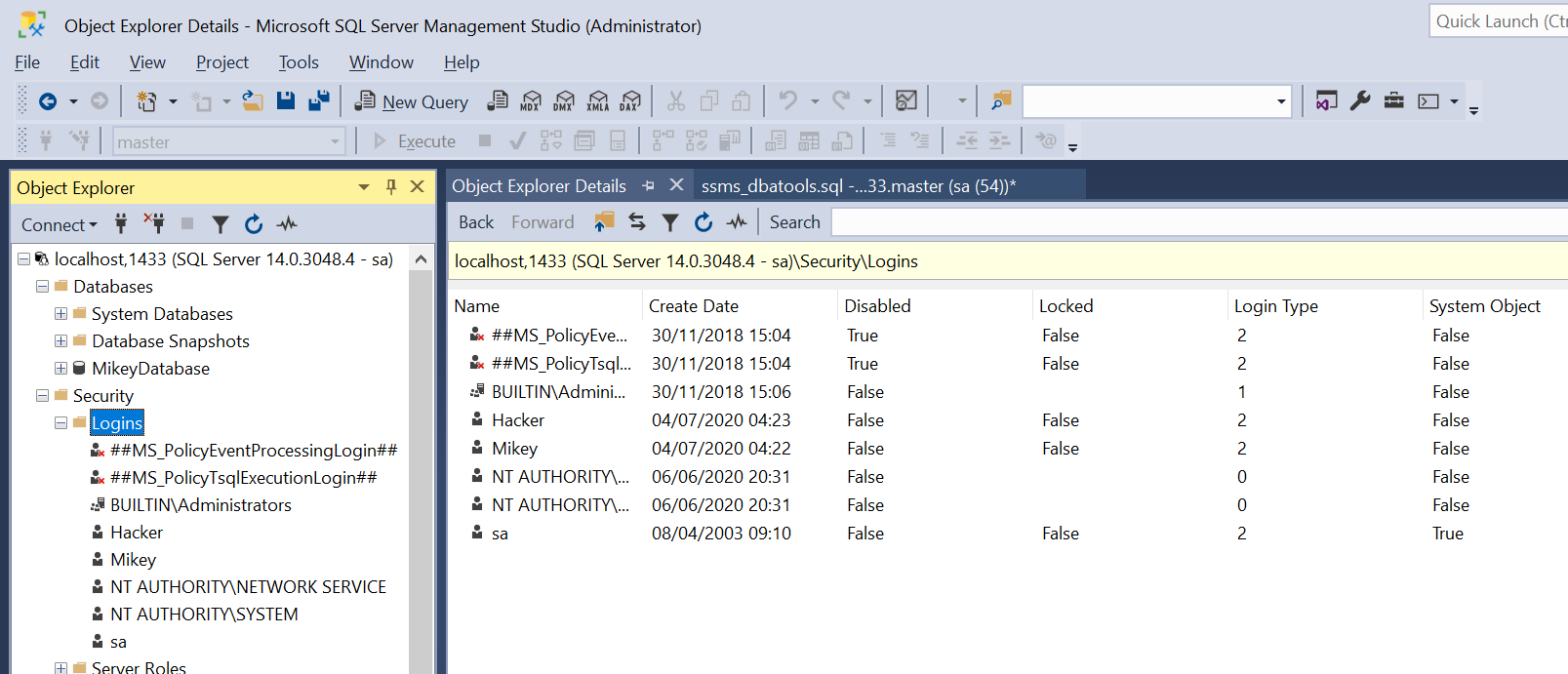
Get-DbaLogin
# see the logins on the server
Get-DbaLogin -SqlInstance $server | Format-Table
<#
ComputerName InstanceName SqlInstance Name LoginType CreateDate LastLogin HasAccess IsLocked IsDisabled
------------ ------------ ----------- ---- --------- ---------- --------- --------- -------- ----------
localhost MSSQLSERVER 4dc570825344 ##MS_PolicyEventProcessingLogin## SqlLogin 30/11/2018 15:04:10 True False True
localhost MSSQLSERVER 4dc570825344 ##MS_PolicyTsqlExecutionLogin## SqlLogin 30/11/2018 15:04:10 True False True
localhost MSSQLSERVER 4dc570825344 BUILTINAdministrators WindowsGroup 30/11/2018 15:06:30 True False
localhost MSSQLSERVER 4dc570825344 Hacker SqlLogin 04/07/2020 04:23:27 True False False
localhost MSSQLSERVER 4dc570825344 Mikey SqlLogin 04/07/2020 04:22:13 True False False
localhost MSSQLSERVER 4dc570825344 NT AUTHORITYNETWORK SERVICE WindowsUser 06/06/2020 20:31:21 True False
localhost MSSQLSERVER 4dc570825344 NT AUTHORITYSYSTEM WindowsUser 06/06/2020 20:31:21 04/07/2020 04:50:23 True False
localhost MSSQLSERVER 4dc570825344 sa SqlLogin 08/04/2003 09:10:35 04/07/2020 04:51:04 True False False
#>
…then database users

Get-DbaDbUser
# see all users of the given database
Get-DbaDbUser -SqlInstance $server -Database MikeyDatabase | Format-Table
<#
ComputerName InstanceName SqlInstance Database CreateDate DateLastModified Name Login LoginType AuthenticationType State HasDbAccess DefaultSchema
------------ ------------ ----------- -------- ---------- ---------------- ---- ----- --------- ------------------ ----- ----------- -------------
localhost MSSQLSERVER 4dc570825344 MikeyDatabase 08/04/2003 09:10:42 04/07/2020 04:18:28 dbo sa SqlLogin Instance Existing True dbo
localhost MSSQLSERVER 4dc570825344 MikeyDatabase 08/04/2003 09:10:42 08/04/2003 09:10:42 guest SqlLogin None Existing False guest
localhost MSSQLSERVER 4dc570825344 MikeyDatabase 13/04/2009 12:59:11 13/04/2009 12:59:11 INFORMATION_SCHEMA SqlLogin None Existing False
localhost MSSQLSERVER 4dc570825344 MikeyDatabase 04/07/2020 04:28:37 04/07/2020 04:28:37 Mikey Mikey SqlLogin Instance Existing True dbo
localhost MSSQLSERVER 4dc570825344 MikeyDatabase 13/04/2009 12:59:11 13/04/2009 12:59:11 sys SqlLogin None Existing False
#>
…now roles, both server and database
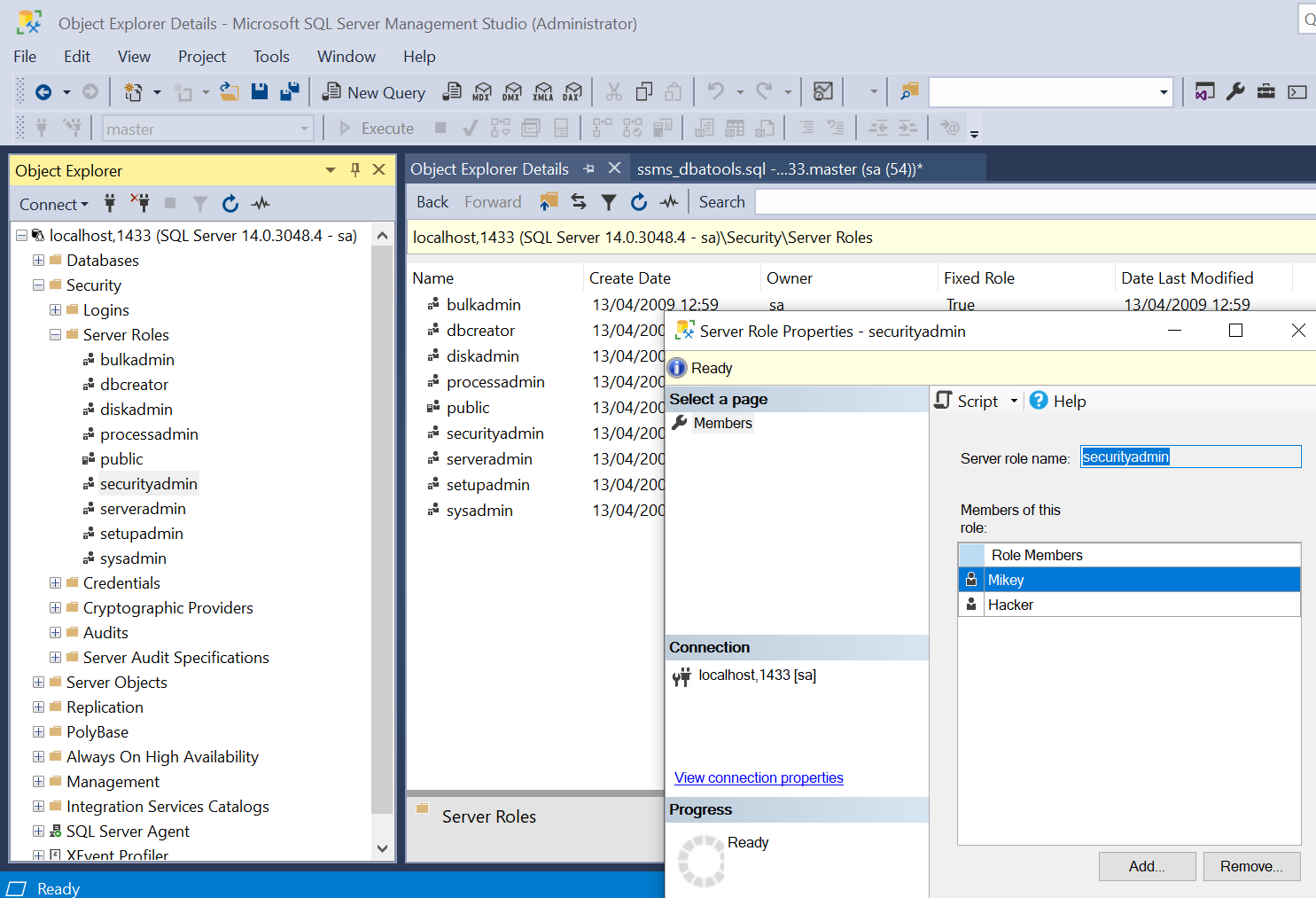
Get-DbaServerRole
# see the server roles
Get-DbaServerRole -SqlInstance $server | Format-Table
# or use this:
# Get-DbaServerRoleMember -SqlInstance $server | Format-Table
<#
ComputerName InstanceName SqlInstance Role Login Owner IsFixedRole DateCreated DateModified
------------ ------------ ----------- ---- ----- ----- ----------- ----------- ------------
localhost MSSQLSERVER 4dc570825344 bulkadmin {} sa True 13/04/2009 12:59:06 13/04/2009 12:59:06
localhost MSSQLSERVER 4dc570825344 dbcreator {Mikey} sa True 13/04/2009 12:59:06 13/04/2009 12:59:06
localhost MSSQLSERVER 4dc570825344 diskadmin {} sa True 13/04/2009 12:59:06 13/04/2009 12:59:06
localhost MSSQLSERVER 4dc570825344 processadmin {} sa True 13/04/2009 12:59:06 13/04/2009 12:59:06
localhost MSSQLSERVER 4dc570825344 public {} sa False 13/04/2009 12:59:06 13/04/2009 12:59:06
localhost MSSQLSERVER 4dc570825344 securityadmin {Mikey, Hacker} sa True 13/04/2009 12:59:06 13/04/2009 12:59:06
localhost MSSQLSERVER 4dc570825344 serveradmin {} sa True 13/04/2009 12:59:06 13/04/2009 12:59:06
localhost MSSQLSERVER 4dc570825344 setupadmin {} sa True 13/04/2009 12:59:06 13/04/2009 12:59:06
localhost MSSQLSERVER 4dc570825344 sysadmin {sa, BUILTINAdministrators, NT AUTHORITYNETWORK SERVICE} sa True 13/04/2009 12:59:06 13/04/2009 12:59:06
#>
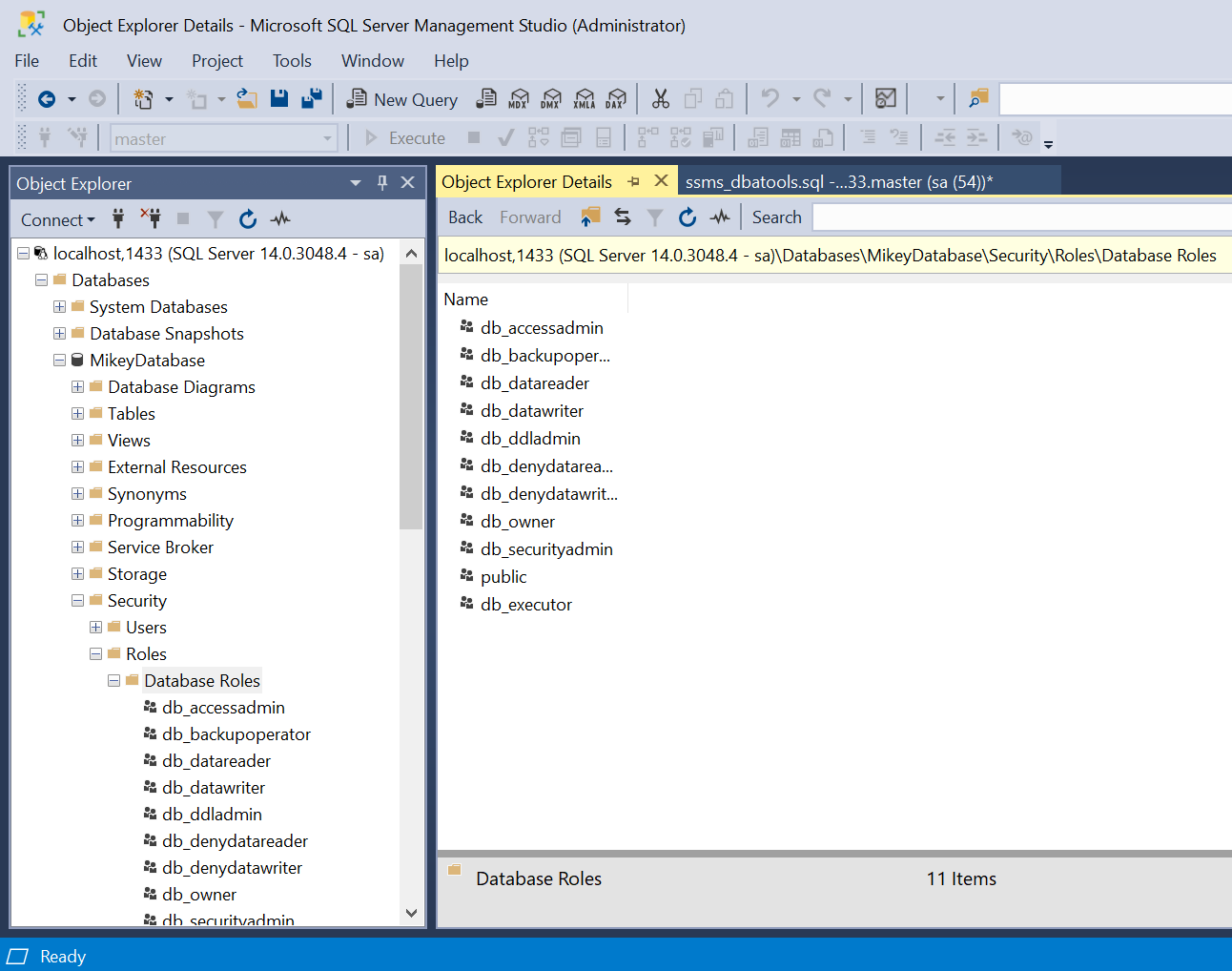
Get-DbaDbRole
# see database roles
Get-DbaDbRole -SqlInstance $server -Database MikeyDatabase | Format-Table
<#
ComputerName InstanceName Database Name IsFixedRole
------------ ------------ -------- ---- -----------
localhost MSSQLSERVER MikeyDatabase db_accessadmin True
localhost MSSQLSERVER MikeyDatabase db_backupoperator True
localhost MSSQLSERVER MikeyDatabase db_datareader True
localhost MSSQLSERVER MikeyDatabase db_datawriter True
localhost MSSQLSERVER MikeyDatabase db_ddladmin True
localhost MSSQLSERVER MikeyDatabase db_denydatareader True
localhost MSSQLSERVER MikeyDatabase db_denydatawriter True
localhost MSSQLSERVER MikeyDatabase db_executor False
localhost MSSQLSERVER MikeyDatabase db_owner True
localhost MSSQLSERVER MikeyDatabase db_securityadmin True
localhost MSSQLSERVER MikeyDatabase public False
#>
Finally, database role members:
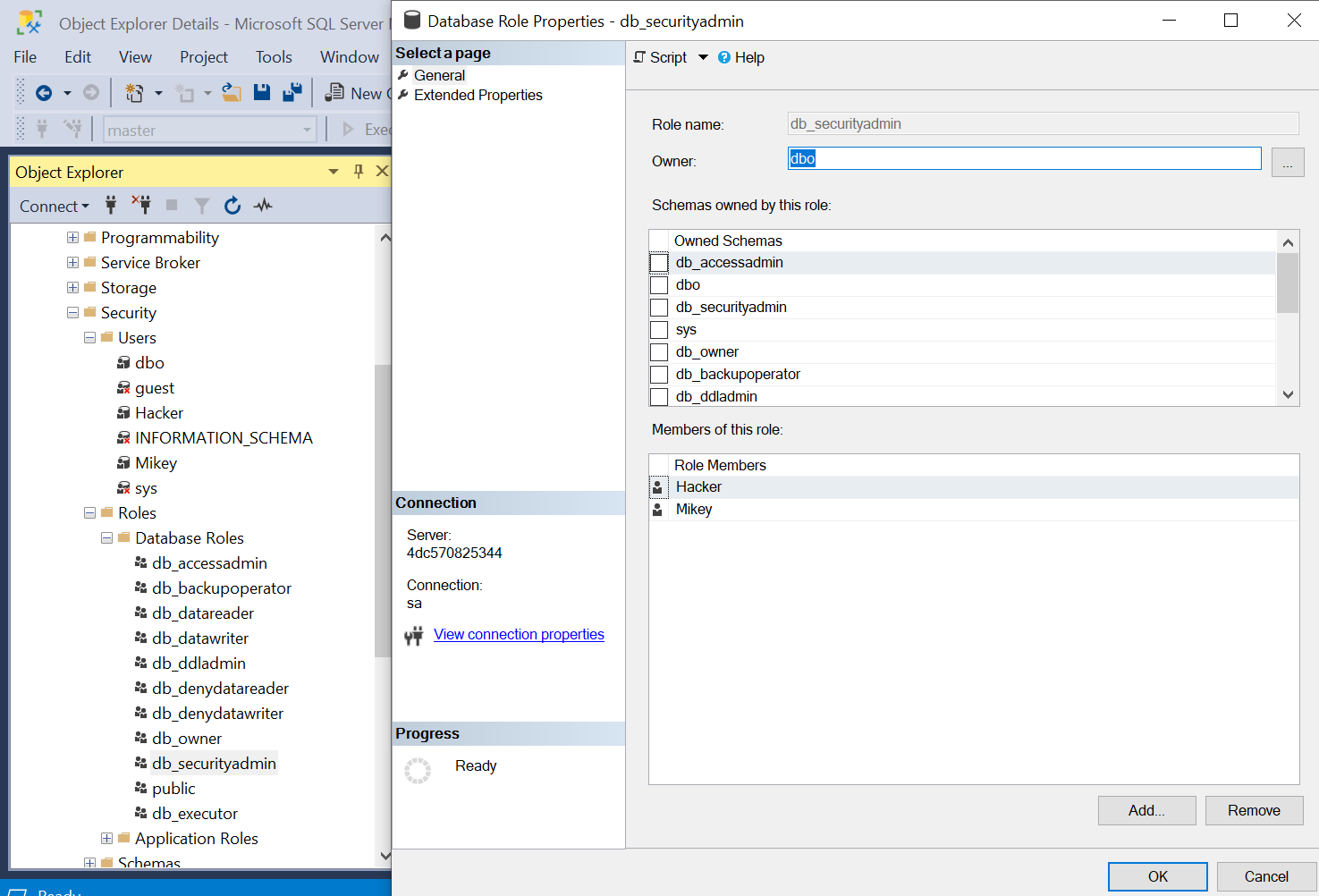
Get-DbaDbRoleMember
# see the role members
Get-DbaDbRoleMember -SqlInstance $server -Database MikeyDatabase | Format-Table
<#
ComputerName InstanceName SqlInstance Database Role UserName Login IsSystemObject LoginType
------------ ------------ ----------- -------- ---- -------- ----- -------------- ---------
localhost MSSQLSERVER 4dc570825344 MikeyDatabase db_denydatareader Hacker Hacker False SqlLogin
localhost MSSQLSERVER 4dc570825344 MikeyDatabase db_denydatawriter Hacker Hacker False SqlLogin
localhost MSSQLSERVER 4dc570825344 MikeyDatabase db_owner Mikey Mikey False SqlLogin
localhost MSSQLSERVER 4dc570825344 MikeyDatabase db_securityadmin Mikey Mikey False SqlLogin
localhost MSSQLSERVER 4dc570825344 MikeyDatabase db_securityadmin Hacker Hacker False SqlLogin
#>
“Now You See Me” - said SQL Server. Of course there is more to see on the server, but I think it is a good teaser and an incentive to start using dbatools module.
Thank you,
Mikey
